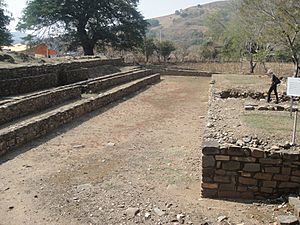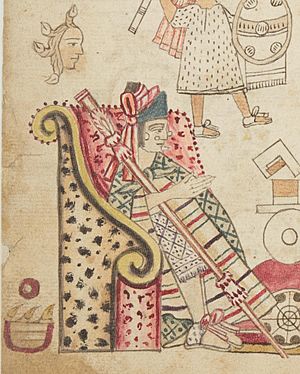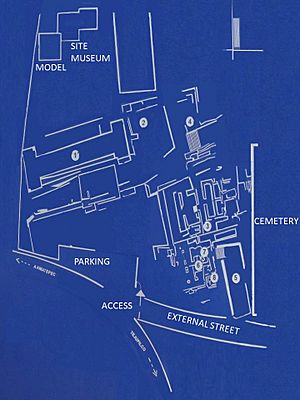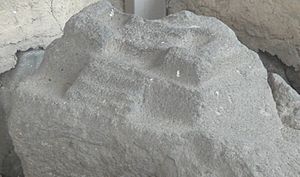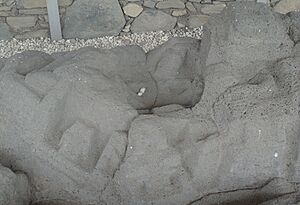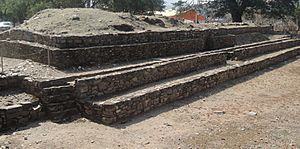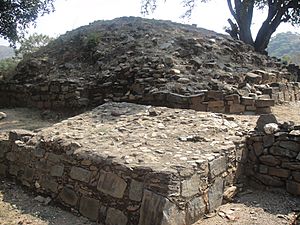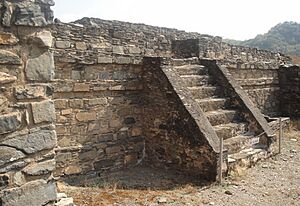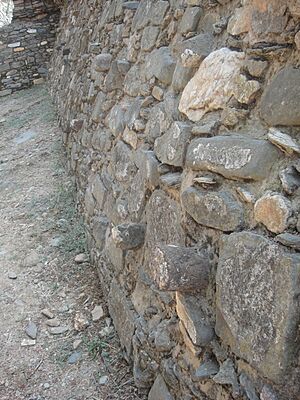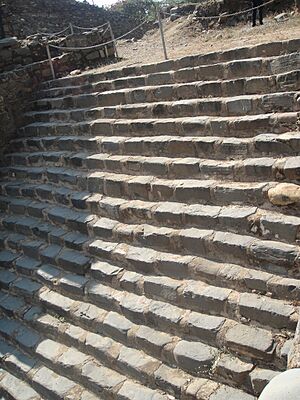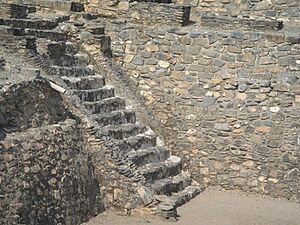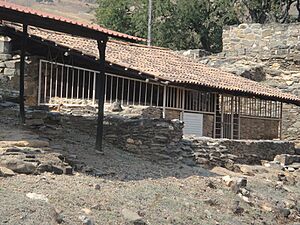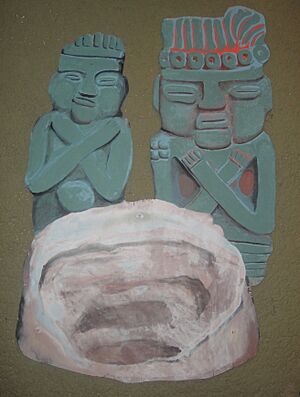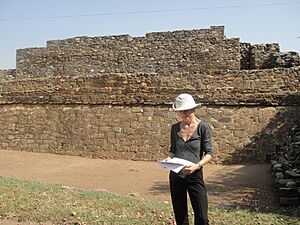San Miguel Ixtapan (archaeological site) facts for kids
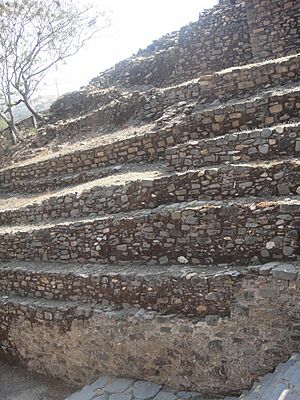
San Miguel Ixtapan, Basement 3
|
|
| Location | San Miguel Ixtapan, Tejupilco (municipality), State of Mexico |
|---|---|
| Coordinates | 18°48′27″N 100°09′19″W / 18.80750°N 100.15528°W |
| History | |
| Founded | 500 CE |
| Abandoned | 1500 CE |
| Periods | Mesoamerican Classical, Postclassical |
| Cultures | Otomí – Toltec – Aztec ( Otomí – Nahuatl languages) |
| Site notes | |
| Website | Template:URL=http://www.gobiernodigital.inah.gob.mx/ZonasArqueologicas/todas/htme/za00917.html |
San Miguel Ixtapan is an amazing ancient site in the State of Mexico, near a town called Tejupilco. It's like a hidden treasure that helps us learn about the people who lived there long ago. This special place is about 100 kilometers west of Toluca, a big city in Mexico.
Archaeologists have explored San Miguel Ixtapan, and it's one of the few ancient sites studied in this part of Mexico. It gives us important clues about a time when the powerful city of Teotihuacan was declining. San Miguel Ixtapan grew a lot between 750 and 900 CE. Many of the buildings you can see today were built during this time. The site was in a great spot with good land for farming and natural springs. It also had special rocks called basalt prisms, which were used for building.
Contents
A Look Back: Ancient Times in Mexico
The area around San Miguel Ixtapan has a very long history. The first signs of people living here date back about 20,000 years! These early people were hunter-gatherers, meaning they hunted animals and gathered plants for food. They used stone tools, and evidence of their lives has been found in many places.
Over thousands of years, people slowly changed their way of life. Between 20,000 and 5,000 BCE, they started to settle down in villages. They learned to farm, growing crops like corn, beans, chili peppers, and squash. They also began making pottery around 2,500 BCE.
One of the earliest big cities in the region was Teotihuacan, built between 100 BCE and 100 CE. Later, around 800 to 900 CE, the Matlatzincas became powerful, with their capital city at Teotenango.
Much later, between 1469 and 1481, the Aztecs and Purépecha groups conquered many Matlatzinca towns. They gave new names to some of these places. Other important groups in the area included the Chichimecas, Acolhuas, Mazahuas, and Otomis.
What's in a Name?
The name "Ixtapan" comes from ancient words meaning "place where there is salt." This is because salt was very important here, even in ancient times. There were natural wells with salty water, which people used to get salt.
The name "Tejupilco" is a bit of a mystery. People think it might come from a large volcanic rock with a human footprint on it. Some ideas for its meaning include "place of small footprint" or "place of important people's footprints."
How We Learn About the Past
Archaeologists first started exploring San Miguel Ixtapan in 1985. Farmers actually discovered the site when they were plowing their fields and found old rocks and other ancient items.
It's hard to know exactly who built the site. However, old stories suggest they were closely related to the Otomi culture.
One interesting discovery was made in 1958: a special stone called "the model." It's a basalt rock with a miniature city carved into it! At first, people thought it was a tiny map of San Miguel Ixtapan. But later digs showed it didn't match the actual site. Now, experts think it might be an ideal picture of a city or a ceremonial center. This amazing stone is now protected under a roof next to the museum.
Different Times, Different People
Archaeologists have found evidence of at least four main periods when people lived at San Miguel Ixtapan:
- First Period (500 to 750 CE): This was during the end of the Classical period. People lived in houses, and archaeologists found small statues from the Teotihuacan culture.
- Second Period (750 to 900 CE): This was the site's golden age! Most of the main buildings were constructed during this time.
- Third Period (900 to 1200 CE): In this period, people reused the main buildings. They made changes and added new parts to them.
- Fourth Period (After 1200 CE): The site was empty for a while. Then, a group related to the Aztecs moved in. They built simple houses over the older ruins. They stayed until the Spanish arrived. The Aztecs might have come here because it was a good place to control trade between different regions. The salt wells were also very valuable!
A Timeline of Tejupilco
Here are some important dates for the region:
- Around 12,000 BCE: The oldest signs of humans in the area. Early hunter-gatherers created cave paintings.
- Around 2,000 BCE: Archaeologists found a mask, a jade necklace, and human remains on top of an unexplored pyramid base at San Miguel Ixtapan. This shows an unknown culture lived here thousands of years before the main site.
- Around 450 CE: The San Miguel Ixtapan culture began to flourish. They likely had strong connections with other big cities like Teotihuacan and Tula.
- Around 1475 CE: The Aztecs conquered the Tejupilco area. After this, people in the region spoke Matlatzinca and Nahuatl (the Aztec language).
Exploring the Ancient Site
Even though the "model" stone was found in 1958, serious archaeological digs didn't start until 1985. The museum was built in 1993.
San Miguel Ixtapan has many ancient buildings and a special museum. The museum displays many items found during the excavations. These objects tell us a lot about the culture and daily life of the people who lived here long ago.
Some small figures found at the site are very old, dating back to 800 to 200 BCE. They look similar to pottery from other ancient sites like Tlapacoya. Some even show pregnant women! Other clay figures are like those found at Teotihuacan, showing people lived here continuously.
The site was most active between 750 and 900 CE. During this time, the main monuments were built. This was a period of great growth, similar to other important cities like Xochicalco, Teotenango, and Cholula.
The museum's most important items are from this golden age. They include human-shaped sculptures with crossed arms, ceramic masks, a stone ring from the ballgame court, and stone disks with carvings of two snakes.
Later, during the Aztec period, there wasn't much new building. However, archaeologists found some rich burials from this time. People were buried with beautiful offerings like shell beads, necklaces, copper needles, earrings, and obsidian tools. These items helped the dead on their journey to the underworld. Many of these treasures are now in the museum.
In the center of the modern town, the Church of San Miguel Ixtapan was built using carved stones from the ancient ruins.
Amazing Ancient Structures
When you visit the site, you'll see two large earth mounds on the right, which cover ancient ruins. On the left is the famous ballgame court.
The Prehispanic Scale Model
Archaeologists believe the "Model" stone was made between 900 and 1200 CE. It's a large basalt rock, about three by four meters. The ancient people carved amazing architectural details into it, like ballgame courts, platforms, stairways, and temples. It shows a detailed ceremonial center in miniature.
Experts don't think it's a map of any known city. Instead, it might have been a special offering used in rituals and ceremonies. It could represent an ideal city, or even a city that was planned but never built. It even has several miniature ballgame courts!
The Ballgame Court
The ballgame court is shaped like a capital "I" or a double "T." It's 50 meters long and 7.50 meters wide. The ends are 15 by 7.8 meters. What's special about this court is that it was built by digging down into the ground. So, stairways were needed to enter it.
On the south side, there's a platform where many human burials were found. These burials had rich offerings and date back to the Postclassical period.
Basement 2
This structure hasn't been fully explored yet, partly because a large tree grows on top of it!
On its eastern side, you can still see traces of red stucco, a type of plaster. The western side has a stairway that goes into the structure.
Basement 3
This is the most important building at the site. It has three layers built on top of each other. At the very top, there are several rooms. You can reach them by a stairway with slanted walls on the sides. The second level has many rooms that were used for living and ceremonies. These rooms were changed and added to over time.
One room at the top might have been a resting place for a king. It still has stucco on its floor and walls. In the northwest corner, there's a small space with a sculpture of Tlaloc, the God of Water. Tlaloc was very important here because water was essential for growing corn and for collecting salt, which were major sources of income.
Stairway 4
North of Basement 3, there's a stairway made of large basalt blocks. It leads down from the Tlaloc niche to an outdoor patio surrounded by a wall. You can also see parts of an ancient drainage system here.
Sunken Patio 5
On the south side of Basement 3 is the "Sunken Patio." This area was used for offerings and rituals hundreds of years ago. It was designed so that everyone attending could see what was happening. Inside, there's a special stone that might have been used for sacrifices.
The patio has two stairways. One of them leads directly to the "Sculptures Enclosure."
Structures 6, 7 & 8
These structures are located south of Basement 3 and west of the Sunken Patio. They are currently closed off to visitors.
These areas include the "Recinto de la Banqueta" (Bench Enclosure) and the "Recinto de las Esculturas" (Sculptures Enclosure).
- Sculptures Enclosure: Inside this structure, archaeologists found many offerings and small figures. They also discovered two green stone sculptures embedded in the floor. These sculptures represent Huiztocihuatl (Goddess of Salt Water) and Tlaloc (Rain God). This area is named for the many basalt green stone figures found here, which are now in the museum.
- Bench Enclosure: This room has stucco on its floor and walls. It might have been a resting place for the king. It also features a ceremonial walkway decorated with stone "nails."
Many of the buildings at San Miguel Ixtapan were covered with stucco. This might have helped protect them from damage, especially during the many invasions the area faced, like the Aztec occupation.
The Site Museum
The museum at San Miguel Ixtapan opened in 1995. It's managed by the "Instituto Mexiquense de Cultura."
Even though it's a small museum, it holds over 800 items! Many of these are perfectly preserved. They are displayed in a smart way, mostly showing objects found as offerings with the dead. Based on the pottery and sculptures, these items mostly come from the Postclassical period.
Some of the oldest ceramic figures, including pregnant women, date back to 800 BCE to 200 CE. Other pieces are from the site's most glorious period, between 750 and 900 CE. These include pottery, figures of gods, and even the skeleton of an important man, displayed just as it was found in one of the mounds.
See also
 In Spanish: Zona arqueológica de San Miguel Ixtapan para niños
In Spanish: Zona arqueológica de San Miguel Ixtapan para niños


